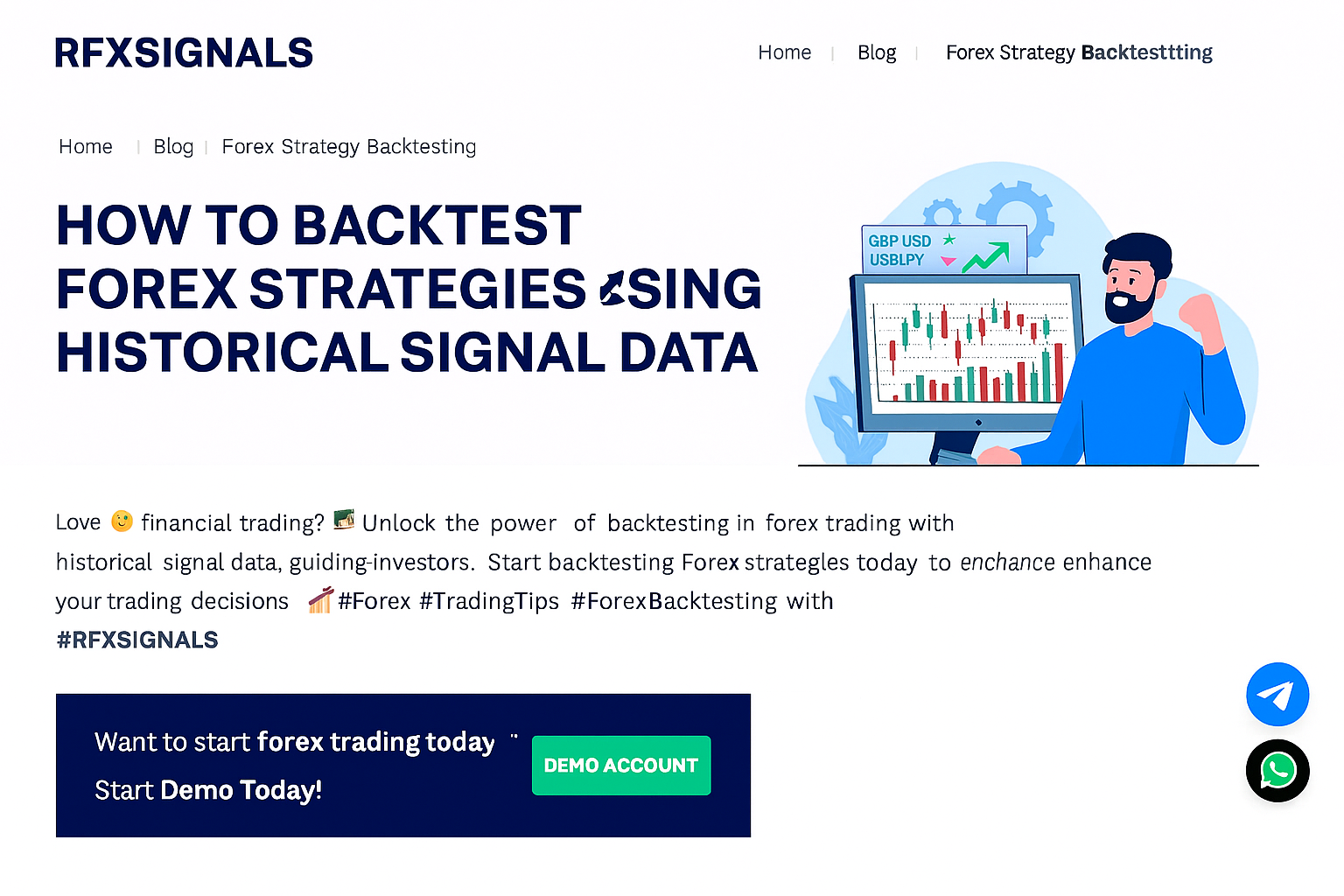
How to Backtest Forex Strategies Using Historical Signal Data
A practical, step-by-step framework for testing trading signals on historical FX data — learn how to prepare data, choose metrics, run tests, and avoid common pitfalls so your live trading has the best chance to succeed.
Why backtesting with historical signal data matters
Backtesting converts signals into measurable evidence. Instead of trusting memory or gut, you validate how a signal would have performed across many market cycles. Historical signal testing helps uncover edge, estimate expectancy, reveal drawdowns, and spot curve-fitting before real capital is at risk.
Step 1 — Define the strategy and hypothesis
Clear rules make reliable tests. Write a one-line hypothesis: e.g., “Buy EUR/USD at breakout of 1-hour consolidation when RSI(14)<30; TP=40 pips; SL=20 pips.” Record timeframes, instruments, signal conditions, trade sizing rules, and execution assumptions (fills/slippage).
Checklist
- Signal trigger (exact conditions)
- Entry, stop, and take-profit rules
- Position sizing and risk per trade
- Trading hours and instrument list
- Assumptions about slippage, spread, commissions
Step 2 — Gather reliable historical signal & price data
Use tick or minute price series when possible, and ensure your historical signals are timestamped consistently (UTC preferred). Common sources: broker historical dumps, premium tick data vendors, and exported signal logs. Keep a separate log of raw signals (timestamp, pair, direction, reason) and price series — never edit the raw signal file after testing starts.
Step 3 — Clean & align data (most common source of errors)
Misaligned timestamps and missing candles are the top causes of false results. Convert all times to one timezone, handle DST if your source uses local time, and fill gaps (or label them). Make sure the signal timestamp matches the price you assume for entry (open, close, mid, ask, or bid?).
Quick data hygiene steps
- Normalize timestamps to UTC.
- Remove duplicates and repair missing ticks/candles.
- Match signal timestamp to bar close or next bar open (explicitly).
- Apply realistic spreads, slippage, and commissions.
Step 4 — Choose backtesting method & tools
You can backtest with Excel (small sample), Python (pandas/backtrader/zipline), or specialized platforms (MetaTrader strategy tester, TradingView Pine Script, Amibroker). For signal-level testing (not rule re-test), feed your signal log into the engine that replays price series and enforces your execution rules.
Recommended approach for signal data
Replay price series bar-by-bar, check for signal triggers at the exact timestamps, and open trades using the assumed execution price (next-bar open or intrabar price). If you lack tick data, conservatively assume worst-case fill within the next bar range.
Step 5 — Define metrics that matter
Beyond net profit, track these metrics:
- Expectancy = (Average win × Win rate) − (Average loss × Loss rate)
- Sharpe ratio (risk-adjusted returns)
- Max Drawdown (peak-to-trough drop)
- Profit factor = Gross profit / Gross loss
- Number of trades (statistical significance)
- Average holding time
Step 6 — Run tests: in-sample, out-of-sample & walk-forward
Split your data: keep an in-sample period to iterate and an out-of-sample period to validate true performance. Walk-forward testing mimics live re-optimization and is ideal when you tune parameters.
Step 7 — Stress test and sensitivity analysis
Introduce realistic frictions: larger spreads, random slippage, missed fills during news, and comission increases. Check how small parameter changes affect performance — if tiny changes destroy the edge, the system is likely overfit.
Step 8 — Review common failure modes
- Data snooping / curve fitting
- Survivorship bias (ex: only testing pairs that survived)
- Look-ahead bias (using future data in rules)
- Incorrect timezone alignment
Step 9 — Convert results to a live plan
If the backtest passes statistical and stress checks, write a clear execution plan: starting capital, risk % per trade, live monitoring rules, stop-loss behavior, and a monthly review schedule. Always forward-test on a small live/sample account before scaling.
Step 10 — Document everything and keep reproducible logs
Store code, raw data, test outputs, and the exact environment (Python versions, platform settings). Use a test report template showing hypothesis, assumptions, metrics, and action decision (deploy / iterate / discard).
- Hypothesis & rules
- Data sources & timeframes
- Assumptions (spread, slippage, commissions)
- In-sample / Out-of-sample periods
- Key metrics & charts (equity curve, DD)
- Decision: Deploy / Further test / Discard
Related posts (internal linking for SEO)
Final checklist before live deployment
- Reproduce test on a clean machine with raw data.
- Run out-of-sample and walk-forward tests.
- Stress test with worse spreads/slippage.
- Document the live execution plan and monitoring rules.
- Begin with small capital & scale systematically.
If you want a ready-to-run backtest template (Python/pandas or MT5 script) specific to your historical signal logs, reply with "Send template" and attach a small sample of your signal CSV (timestamp,pair,direction,reason) — I'll format a reproducible starter.